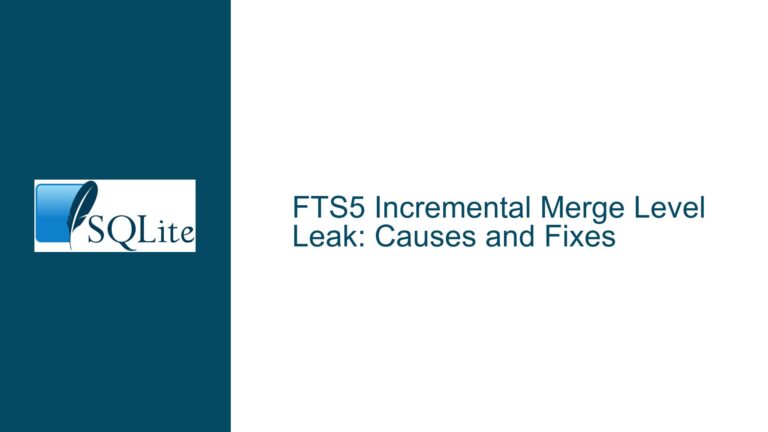Optimizing SQLite In-Memory Database Insert Performance for Large Datasets
Understanding the Bottlenecks in SQLite In-Memory Insert Performance
When working with SQLite in-memory databases, especially for large-scale data insertion tasks, performance bottlenecks can arise from several areas. In this scenario, the primary issue revolves around inserting 100 million rows into a table with a composite primary key consisting of three integers and a string column. The database grows to approximately 9GB, and the initial insertion rate is around 18,000 rows per second, taking about 90 minutes to complete. Profiling reveals that 75% of the time is spent in memcpy_repmovs(), and 97% of the time is consumed by sqlite3BtreeMovetoUnpacked(). These observations suggest that memory operations and B-tree traversal are the primary bottlenecks.
The memcpy_repmovs() function is responsible for copying memory blocks, which is a common operation during data insertion. The high CPU usage by memcpy() indicates that the system is spending a significant amount of time moving data around in memory. This is somewhat expected given the volume of data being inserted, but the extent of the bottleneck suggests that there may be inefficiencies in how the data is being handled. The sqlite3BtreeMovetoUnpacked() function is part of SQLite’s B-tree implementation, which is used to locate the correct position for inserting a new row. The high time spent in this function indicates that the B-tree structure is being heavily traversed during insertion, which can be costly, especially if the inserts are not in primary key order.
Exploring the Root Causes of Performance Issues
Several factors contribute to the observed performance issues in this scenario. First, the order of insertion plays a critical role. If inserts are not in primary key order, the B-tree structure must be traversed more extensively to find the correct insertion point for each row. This results in more frequent and costly operations, as each insert may require accessing multiple leaf and index pages. In contrast, inserting rows in primary key order allows for more sequential access patterns, reducing the number of B-tree traversals and improving performance.
Another factor is the transaction size. Larger transactions can reduce the overhead associated with committing each individual insert, but they also increase the memory footprint and the complexity of managing the transaction. The initial transaction size of 50,000 rows may not be optimal, and adjusting this parameter could yield performance improvements. Additionally, the use of WAL (Write-Ahead Logging) mode and setting synchronous=0 can significantly improve insert performance by reducing the overhead associated with disk I/O, even in an in-memory database.
Memory allocation is another critical factor. The high usage of malloc() suggests that the system is spending a significant amount of time allocating memory for new rows. This can be influenced by the page size and the initial size of the page cache. SQLite’s default page size and cache settings may not be optimal for this specific workload, and adjusting these parameters could reduce the frequency of memory allocations and improve performance.
Strategies for Improving SQLite In-Memory Insert Performance
To address the performance bottlenecks, several strategies can be employed. First, ensuring that inserts are in primary key order can significantly reduce the time spent in sqlite3BtreeMovetoUnpacked(). This change alone improved performance by 80% in the scenario described, reducing the time spent in memcpy() to around 15% and shifting the bottleneck to malloc(). This indicates that memory allocation is now the primary constraint.
Adjusting the page size and initial page cache size can help mitigate the memory allocation bottleneck. The page size should be set before the database is created, and for in-memory databases, this can be done using the SQLITE_DEFAULT_PAGE_SIZE compile-time option. Increasing the page size can reduce the number of memory allocations required, as each page can hold more rows. Similarly, increasing the initial size of the page cache using the SQLITE_DEFAULT_PCACHE_INITSZ option can reduce the frequency of cache resizing operations, further improving performance.
Using the WITHOUT ROWID option can also improve performance for tables with a composite primary key. This option changes the underlying storage structure from a row-based format to a key-value format, which can be more efficient for certain types of queries and inserts. In this scenario, using WITHOUT ROWID in combination with WAL mode and synchronous=0 allowed the insertion rate to increase to 250,000 rows per second.
For further optimization, consider using incremental BLOB I/O to reduce the amount of memory copying required for large strings. This approach allows data to be written directly to the database without intermediate copies, which can be particularly beneficial when dealing with large strings or binary data. Additionally, if the data to be loaded does not change frequently, a two-phase approach can be used. In the first phase, a preprocessing program creates the database in memory and saves a snapshot to disk using the VACUUM INTO statement. In the second phase, the main program uses the backup API to load the snapshot from disk into memory, which is much faster than inserting rows individually.
Finally, if the data can be split across multiple tables, using concurrent transactions with the BEGIN CONCURRENT statement can leverage multiple cores for transaction execution. This approach requires compiling SQLite from the begin-concurrent branch and creating separate connections for each thread. Each connection writes to a separate table, ensuring that commits do not conflict. This can provide a significant uplift in throughput, depending on the transaction size and the number of cores available.
In conclusion, optimizing SQLite in-memory database insert performance for large datasets requires a combination of strategies, including optimizing the order of inserts, adjusting transaction size, using WAL mode, tuning memory allocation parameters, and leveraging advanced features like WITHOUT ROWID and incremental BLOB I/O. By carefully analyzing the bottlenecks and applying these techniques, it is possible to achieve significant performance improvements and reduce the time required for large-scale data insertion tasks.






